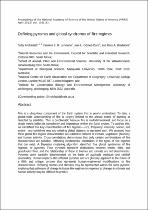JavaScript is disabled for your browser. Some features of this site may not work without it.
- ResearchSpace
- →
- Research Publications/Outputs
- →
- Journal Articles
- →
- View Item
| dc.contributor.author |
Archibald, S

|
|
| dc.contributor.author |
Lehmann, CER

|
|
| dc.contributor.author |
Gómez-Dans, JL

|
|
| dc.contributor.author |
Bradstock, RA

|
|
| dc.date.accessioned | 2013-07-18T09:52:04Z | |
| dc.date.available | 2013-07-18T09:52:04Z | |
| dc.date.issued | 2013-04 | |
| dc.identifier.citation | Archibald, S, Lehmann, C.E.R, Gómez-Dans, J.L and Bradstock, R.A. 2013. Defining pyromes and global syndromes of fire regimes. Proceedings of the National Academy of Science of the United States of America, vol. 110(16), pp 1-6 | en_US |
| dc.identifier.issn | 0027-8424 | |
| dc.identifier.uri | http://www.pnas.org/content/110/16/6442 | |
| dc.identifier.uri | http://hdl.handle.net/10204/6896 | |
| dc.description | Copyright: 2013 National Academy of Sciences. This is an ABSTRACT ONLY. The definitive version is published in Proceedings of the National Academy of Science of the United States of America, pp 1-6 | en_US |
| dc.description.abstract | Fire is a ubiquitous component of the Earth system that is poorly understood. To date, a global-scale understanding of fire is largely limited to the annual extent of burning as detected by satellites. This is problematic because fire is multidimensional, and focus on a single metric belies its complexity and importance within the Earth system. To address this, we identified five key characteristics of fire regimes—size, frequency, intensity, season, and extent—and combined new and existing global datasets to represent each. We assessed how these global fire regime characteristics are related to patterns of climate, vegetation (biomes), and human activity. Cross-correlations demonstrate that only certain combinations of fire characteristics are possible, reflecting fundamental constraints in the types of fire regimes that can exist. A Bayesian clustering algorithm identified five global syndromes of fire regimes, or pyromes. Four pyromes represent distinctions between crown, litter, and grassfueled fires, and the relationship of these to biomes and climate are not deterministic. Pyromes were partially discriminated on the basis of available moisture and rainfall seasonality. Human impacts also affected pyromes and are globally apparent as the driver of a fifth and unique pyrome that represents human-engineered modifications to fire characteristics. Differing biomes and climates may be represented within the same pyrome, implying that pathways of change in future fire regimes in response to changes in climate and human activity may be difficult to predict. | en_US |
| dc.language.iso | en | en_US |
| dc.publisher | National Academy of Sciences | en_US |
| dc.relation.ispartofseries | Workflow;11222 | |
| dc.subject | Fire-climate-vegetation feedbacks | en_US |
| dc.subject | Energetic constraints | en_US |
| dc.subject | Fire intensity | en_US |
| dc.subject | Fire return period | en_US |
| dc.subject | Fire size | en_US |
| dc.title | Defining pyromes and global syndromes of fire regimes | en_US |
| dc.type | Article | en_US |
| dc.identifier.apacitation | Archibald, S., Lehmann, C., Gómez-Dans, J., & Bradstock, R. (2013). Defining pyromes and global syndromes of fire regimes. http://hdl.handle.net/10204/6896 | en_ZA |
| dc.identifier.chicagocitation | Archibald, S, CER Lehmann, JL Gómez-Dans, and RA Bradstock "Defining pyromes and global syndromes of fire regimes." (2013) http://hdl.handle.net/10204/6896 | en_ZA |
| dc.identifier.vancouvercitation | Archibald S, Lehmann C, Gómez-Dans J, Bradstock R. Defining pyromes and global syndromes of fire regimes. 2013; http://hdl.handle.net/10204/6896. | en_ZA |
| dc.identifier.ris | TY - Article AU - Archibald, S AU - Lehmann, CER AU - Gómez-Dans, JL AU - Bradstock, RA AB - Fire is a ubiquitous component of the Earth system that is poorly understood. To date, a global-scale understanding of fire is largely limited to the annual extent of burning as detected by satellites. This is problematic because fire is multidimensional, and focus on a single metric belies its complexity and importance within the Earth system. To address this, we identified five key characteristics of fire regimes—size, frequency, intensity, season, and extent—and combined new and existing global datasets to represent each. We assessed how these global fire regime characteristics are related to patterns of climate, vegetation (biomes), and human activity. Cross-correlations demonstrate that only certain combinations of fire characteristics are possible, reflecting fundamental constraints in the types of fire regimes that can exist. A Bayesian clustering algorithm identified five global syndromes of fire regimes, or pyromes. Four pyromes represent distinctions between crown, litter, and grassfueled fires, and the relationship of these to biomes and climate are not deterministic. Pyromes were partially discriminated on the basis of available moisture and rainfall seasonality. Human impacts also affected pyromes and are globally apparent as the driver of a fifth and unique pyrome that represents human-engineered modifications to fire characteristics. Differing biomes and climates may be represented within the same pyrome, implying that pathways of change in future fire regimes in response to changes in climate and human activity may be difficult to predict. DA - 2013-04 DB - ResearchSpace DP - CSIR KW - Fire-climate-vegetation feedbacks KW - Energetic constraints KW - Fire intensity KW - Fire return period KW - Fire size LK - https://researchspace.csir.co.za PY - 2013 SM - 0027-8424 T1 - Defining pyromes and global syndromes of fire regimes TI - Defining pyromes and global syndromes of fire regimes UR - http://hdl.handle.net/10204/6896 ER - | en_ZA |






